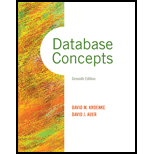
Explanation of Solution
Determinant in following relation:
Assumption 1:
PetName → (PetType, PetBreed, PetDOB, OwnerLastName, OwnerFirstName, OwnerPhone, OwnerEmail)
In the above expression, PetName attribute determines PetType, PetBreed, PetDOB, OwnerLastName, OwnerFirstName, OwnerPhone, and OwnerEmail attributes, left term “PetName” refers the determinant, and “→” defines the relationship.
- That is, the PetType, PetBreed, PetDOB, OwnerLastName, OwnerFirstName, OwnerPhone, and OwnerEmail are functionally dependent on PetName.
Therefore, the “PetName” is the determinant for this assumption.
Assumption 2:
OwnerEmail → (OwnerLastName, OwnerFirstName, OwnerPhone)
In the above expression, OwnerEmail attribute determines OwnerLastName, OwnerFirstName, and OwnerPhone attributes, left term “OwnerEmail” refers the determinant, and “→” defines the relationship.
- That is, the OwnerLastName, OwnerFirstName, and OwnerPhone are functionally dependent on OwnerEmail.
Therefore, the “OwnerEmail” is the determinant for this assumption.
Assumption 3:
OwnerPhone → (OwnerLastName, OwnerFirstName, OwnerEmail)
In the above expression, OwnerPhone attribute determines OwnerLastName, OwnerFirstName, and OwnerEmail attributes, “OwnerPhone” refers the determinant, and “→” defines the relationship.
- That is, the OwnerLastName, OwnerFirstName, and OwnerEmail are functionally dependent on OwnerPhone.
Therefore, the “OwnerPhone” is the determinant for this assumption.
Assumption 4:
(PetName, Date) → (Service, Charge)
In the above expression, the last functional dependency assumes a pet is seen at most on one day, and that there is no standard charge for a service.
- The Service and Charge attribute are functionally dependent on the composite (PetName, Date)...
Want to see the full answer?
Check out a sample textbook solution
Chapter 2 Solutions
Database Concepts (7th Edition)
- The model above needs some improvement. Where you can apply all the normalization rules to attributes. Furthermore, you also need to explain entities and relations between them, and the purpose of attributes by showing why and how they exist ?.arrow_forwardConvert the ER diagram to relations in the normal manner to capture as many constraints as possible, and then identify which of the answers is a relation schema. A. Dependents(ID, name, bDate) B. Employees(ID, name, street, city, state, phones, sDate, lengthEmp) C. Coverage(ID, name) D. Employees(ID, name, street, city, state, sDate, lengthEmp)arrow_forwardShow that if a relation has no attribute that is functionally determined by all the other attributes, then the relation has no nontrivial FD’s at all.arrow_forward
- You are given a relation R with the following attributes R(A,B,C,D,E). Assume that you were given the following functional dependencies: • FD1= AB -> E • FD2: = D -> C (a) What is a valid key for this relation? justify your response. (b) Is this relation in 3NF (Third Normal Form)? Justify your response. If it is not in 3NF, normalize the relation and demonstrate all steps of normalization.arrow_forwardTranslate the E/R diagram that you draw in the previous question into a set of relations, clearly marking all references and keys. Also explain your translation with a paragraph. thats the previous question :Draw an Entity Relationship diagram for modeling the following system. Use relational modelling techniques in your design. You are free to make reasonable assumptions for your model unless they conflict with the definition below. Also explain your design with a paragraph. [Caution: Create your solution using paper and pen. Then put the image of your solution here. Drawing/writing with computer tools will not be accepted. Also include your name and signature in the solution paper]Problem definition: “There is a need to keep track of data for a hospital. The hospital building consists of several departments. Each department is identified with its name. For each department, the following data should also be stored: the number of floors, opening hour, and closing hour. Each…arrow_forwardTransform the following E-R diagram into relationsarrow_forward
- Question 3: a) Why do we need relations? Where do we use it? b) Why do we need proofs? Where do we use it?arrow_forwardConsider the unnormalized relation R with six attributes ABCDEF and the following functional dependencies:AB ->CDEB -> FC -> Da) What is the key(s) for the relation?b) What is the normal form of this relation? Explain it.c) Decompose R into 3NF relations step by step if it is not in 3NF.arrow_forwardMany one-to-many connections may be pieced together to form a connection like the second track. Do the constraints of having a primary and foreign key impose the many-to-one cardinality limitation on the relation? Can you explain why you think that?arrow_forward
- It is possible to can convert any weak entity set to a strong entity set by simply addingappropriate attributes. Why, then, do we have weak entity sets?arrow_forwardCould you please provide an explanation of the three circumstances in which a surrogate key need to be created in place of the main key of a relation?arrow_forwardConvert the following ERD in Chen's notation to an ERD in IE notation. All entities, attributes, and relationships are artificial. You need to clearly show strong and weak entities, foreign key migrations, total participations and partial participations, and cardinality ratios. 02 a1 e2_a2 1_a1 01 a1 e1_a2 1 E2 R1 E1 r2_a1 1 r5_a1 R2 R5 r3_a1 N e3 a1 e3_a2 e3_a3 e4_a1 R3 e4_a2 E4 R4 ЕЗ r8_a1 r7_a1 1 R7 1 R8 N r6_a1 e5_a1 e5_a2 r6_a2 e6 a1 E6 R6 M Е5 e6_a2 r9_a1 1 R9 r9_a2 e7_a2 r10_a1 e7 a1 e8_a1 N e8_a2 E8 R10 E7arrow_forward
 Database System ConceptsComputer ScienceISBN:9780078022159Author:Abraham Silberschatz Professor, Henry F. Korth, S. SudarshanPublisher:McGraw-Hill Education
Database System ConceptsComputer ScienceISBN:9780078022159Author:Abraham Silberschatz Professor, Henry F. Korth, S. SudarshanPublisher:McGraw-Hill Education Starting Out with Python (4th Edition)Computer ScienceISBN:9780134444321Author:Tony GaddisPublisher:PEARSON
Starting Out with Python (4th Edition)Computer ScienceISBN:9780134444321Author:Tony GaddisPublisher:PEARSON Digital Fundamentals (11th Edition)Computer ScienceISBN:9780132737968Author:Thomas L. FloydPublisher:PEARSON
Digital Fundamentals (11th Edition)Computer ScienceISBN:9780132737968Author:Thomas L. FloydPublisher:PEARSON C How to Program (8th Edition)Computer ScienceISBN:9780133976892Author:Paul J. Deitel, Harvey DeitelPublisher:PEARSON
C How to Program (8th Edition)Computer ScienceISBN:9780133976892Author:Paul J. Deitel, Harvey DeitelPublisher:PEARSON Database Systems: Design, Implementation, & Manag...Computer ScienceISBN:9781337627900Author:Carlos Coronel, Steven MorrisPublisher:Cengage Learning
Database Systems: Design, Implementation, & Manag...Computer ScienceISBN:9781337627900Author:Carlos Coronel, Steven MorrisPublisher:Cengage Learning Programmable Logic ControllersComputer ScienceISBN:9780073373843Author:Frank D. PetruzellaPublisher:McGraw-Hill Education
Programmable Logic ControllersComputer ScienceISBN:9780073373843Author:Frank D. PetruzellaPublisher:McGraw-Hill Education





